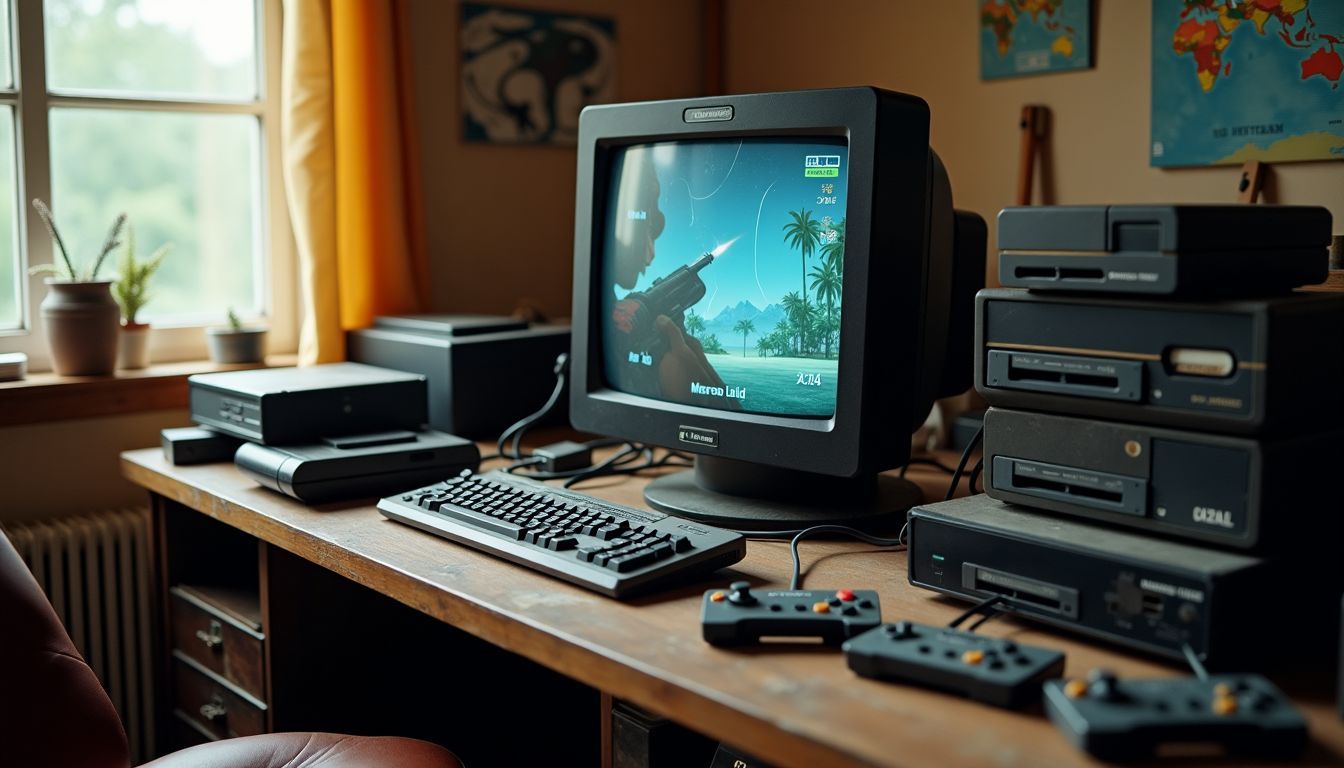Many gamers wonder how popular are first person shooter games in today’s gaming world. FPS games rank as the second most played video game type globally, with millions of active players daily.
These games offer fast action, team play, and amazing graphics that keep players coming back for more. Get ready to discover five big trends that will make FPS games even bigger in 2025.
Key Takeaways
FPS games rank second globally in video game popularity, capturing 38% of the gaming market in 2023. The genre will see massive growth by 2025, driven by competitive esports and streaming.
Free-to-play models have transformed FPS gaming, with titles like Apex Legends and Call of Duty: Warzone attracting millions of players. Cross-platform play lets gamers compete across PC, console, and mobile devices.
The esports industry shows incredible growth, projected to reach $5.7 billion by 2028. Major tournaments offer multi-million dollar prize pools. CS:GO hit 24 million monthly active users in February 2020.
Virtual reality is reshaping FPS games through immersive experiences. New tech includes haptic feedback suits and eye-tracking systems. Games like Half-Life: Alyx showcase VR’s potential in shooter games.
Studies show FPS games improve player reflexes and decision-making skills. However, excessive gaming can lead to negative effects. About 80% of FPS players join gaming clans for social interaction.
Table of Contents
The Appeal of First Person Shooter Games

First-person shooter games put players right into the action with a gun in their hands and enemies in their sights. These games grab players through intense battles and quick decisions, much like what made Doom and Wolfenstein 3D huge hits in gaming history.
Immersive Gameplay

FPS games create a deep sense of presence through their immersive gameplay. Modern shooters like DOOM Eternal and Halo Infinite put players directly into the action with stunning graphics and responsive controls.
According to Niels Bosch at AmongTech, larger gaming monitors boost immersion in games like Counter-Strike 2 by filling more of your field of view.
You don’t just play an FPS game – you live inside it. – John Carmack, id Software founder
The stats back this up – FPS games grabbed 38% of the gaming market in 2023 thanks to their ability to transport players into virtual battlefields.
I’ve spent countless hours in games like Team Fortress 2 and Apex Legends, where the first-person view makes me feel like I’m really there. The mix of 3D sound, detailed environments, and natural movement creates a strong connection between player and character.
Virtual reality takes this even further by tracking head movement and hand gestures for an extra layer of realism. Modern FPS titles use advanced graphics and physics to react naturally to player actions, making the virtual worlds feel alive and responsive.
Competitive Nature
 Competitive gaming drives the heart of first-person shooter games. Players battle against each other in fast-paced matches that test their skills, reflexes, and strategic thinking.
Competitive gaming drives the heart of first-person shooter games. Players battle against each other in fast-paced matches that test their skills, reflexes, and strategic thinking.
The rush of scoring headshots in Counter-Strike: Global Offensive or capturing objectives in Call of Duty creates an addictive thrill. Global eSports audiences will reach 640 million by 2025, proving the massive appeal of competitive FPS action.
The multiplayer aspect fuels intense rivalries and friendships within gaming communities. Team-based modes like those in Halo: Combat Evolved push players to coordinate tactics and communicate effectively.
Players can track their progress through ranking systems, unlockable achievements, and competitive leagues. This competitive spirit leads naturally into the social aspects of these games through their multiplayer modes.
Social Interaction Through Multiplayer Modes

Multiplayer modes in FPS games create strong social bonds among players. Studies show that 80% of FPS gamers join clans, forming tight-knit groups who play and strategize together.
These social connections go beyond just gaming – players chat, share tips, and build real friendships through voice chats and team coordination.
FPS games like Call of Duty and Halo: Combat Evolved push players to work as teams. The social aspect shows up in team-based missions, where players must talk and plan together to win.
Players spend more time in online FPS games because they enjoy playing with friends and meeting new people. This mix of gaming and social interaction makes FPS games more fun than playing alone.
The Evolution of First Person Shooter Games

First-person shooter games started small in the 1970s with basic graphics and simple gameplay in Maze War. The genre exploded in the 1990s with DOOM and Wolfenstein 3D, which brought fast action and better graphics that changed gaming forever.
Origins in the 1970s and 1980s

The birth of shooter games traces back to 1973 with Maze War. This significant game ran on ARPANET and let players shoot at each other in a 3D maze. The game sparked a new genre by mixing shooting with network play.
Maze War paved the way for future multiplayer games.
Battlezone hit arcades in 1980 and brought vector graphics to life. The game put players in a tank cockpit and became a huge hit in homes and arcades. By 1987, Midi Maze took gaming further with 16-player battles and custom mazes.
These early games created the basic rules that modern shooters still follow today.
Early Innovations: 1990s
First-person shooter games exploded in popularity during the 1990s. Id Software changed gaming forever with Wolfenstein 3D in 1992, creating the first true FPS game. Players moved through 3D corridors, shot enemies, and experienced action from a first-person viewpoint.
Doom arrived in 1993 and pushed boundaries even further with better graphics, multiplayer deathmatches, and smart lighting effects. These games laid the foundation for modern FPS titles.
Major innovations kept coming throughout the decade. Quake made history in 1996 by introducing fully 3D maps and real online multiplayer gaming. Games like GoldenEye 007 brought FPS action to home consoles, while Half-Life mixed shooting with strong storytelling.
Marathon Trilogy gave Mac users their own FPS series to enjoy. As graphics and gameplay got better, more people started playing shooter games. These 1990s breakthroughs set the stage for huge changes in online gaming during the 2000s.
Rise of Online Multiplayer in the 2000s
The 2000s marked a huge shift in shooter games through online multiplayer features. Games like Counter-Strike turned team-based combat into a global phenomenon in 1999. Players could now get better at shooter games by practicing with others across the world.
Battlefield 1942 pushed boundaries in 2002 with massive 64-player battles, while Halo: Combat Evolved changed console gaming forever with its two-weapon system and health regeneration.
Online multiplayer didn’t just change how we play – it changed who we play with – John Carmack
The rise of broadband internet made online gaming more accessible to millions of players. Team Fortress 2 and other team-based shooters created strong communities through voice chat and cooperative gameplay.
These games turned casual players into dedicated fans who spent countless hours mastering tactics and strategies with their online teammates.
Advancements in Graphics and Gameplay: 2010s
Graphics in FPS games took huge leaps during the 2010s. Games moved from basic pixels to stunning lifelike visuals that made players feel part of the action. Modern engines powered games like Call of Duty with advanced lighting, realistic shadows, and detailed textures.
Players saw better character models, smoother animations, and more realistic environments.
Game mechanics grew more complex through the decade. VR technology brought new ways to play shooter games, putting players right inside virtual battlefields. FPS titles added features like destructible environments, advanced AI enemies, and deeper storylines.
Modern Warfare raised the bar with emotional storytelling and contemporary warfare settings that felt real. These improvements made shooting games more immersive than ever before.
Integration of VR Technology: 2020s to Present
Modern gaming graphics paved the way for virtual reality to take center stage in first-person shooters. VR technology now offers players a chance to step inside their favorite FPS games with full 360-degree views and motion controls.
The VR gaming market keeps growing fast, bringing new ways to play shooter games like Half-Life: Alyx and Doom VFR.
Players can now feel every shot and explosion through special haptic feedback suits. These suits let gamers experience physical sensations from their in-game actions. Eye-tracking systems make VR games look better and feel smoother by focusing graphics power where players look.
This tech helps reduce motion sickness that some people get while playing VR shooter games.
Factors Contributing to Popularity

First-person shooter games have grown more popular due to their easy access on phones, computers, and gaming consoles. The rise of free games with optional purchases has brought millions of new players to titles like Apex Legends and Call of Duty: Warzone.
Accessibility Across Platforms (PC, Console, Mobile)
FPS games now reach more players than ever through cross-platform play. PC gamers team up with console buddies in games like Call of Duty and Apex Legends. Mobile versions of these shooter games pack the same punch as their bigger siblings.
Cross-platform gaming breaks down walls between players, creating one massive battleground. – John Carmack
The rise of 5G networks makes cloud gaming better, letting players jump into matches from any device.
Game studios build their FPS titles to work on many systems at once. Players can start a match on their PS5, switch to mobile during lunch, and finish on PC at night. This freedom draws in more gamers to the FPS genre.
Cloud gaming tech helps run graphics-heavy games like Halo on basic devices, making shooter games open to everyone.
Free-to-Play Models and In-Game Purchases
Free-to-play shooter games have changed how players spend money on gaming. Popular titles like Apex Legends and Team Fortress 2 let players jump into matches without paying a dime.
The basic game stays free forever, while cool extras like character skins and weapon upgrades cost real money. This model works great for both casual and serious players.
Game studios make big profits through small purchases that add up over time. Players can buy battle passes, loot boxes, or direct cosmetic items to stand out in matches. Many free-to-play shooters earn millions through these micro-transactions alone.
The success of this model has pushed more developers to release their games for free. Regular updates and new content keep players excited about spending money on their favorite games.
The next big trend shaping FPS popularity involves streaming platforms and competitive gaming scenes.
Regular Updates and Expansions
Regular updates keep FPS games fresh and exciting for players. Game studios push out new content like maps, weapons, and game modes every few months. These updates fix bugs and add features that players want.
Popular games like Call of Duty and Apex Legends roll out battle passes with cool rewards. Players love getting new stuff to unlock through gameplay.
Top FPS games stay alive through smart expansion plans. Counter-Strike: Global Offensive proves this with its operation updates that bring new missions. Halo: Master Chief Collection breathed new life into classic games through careful updates.
The best part? Many updates come free with the base game. Players can jump right in and enjoy new content without extra costs. This keeps the gaming community active and growing strong.
Streaming and Competitive Esports
Streaming platforms like Twitch have changed how fans enjoy first-person shooter games. Pro players stream their gameplay live to millions of viewers who learn new tactics and strategies.
These streams create direct connections between top players and their fans through live chat. The esports scene keeps growing bigger, with FPS tournaments drawing massive crowds both online and in person.
Major events now pull in hundreds of millions of viewers who want to see the best bad at FPS games compete at games like Counter-Strike and Call of Duty.
The money in FPS esports tells an amazing growth story. The industry will make $4.3 billion in 2024 and reach $5.7 billion by 2028. Games like Overwatch and Apex Legends host huge tournaments with prize pools worth millions.
Top players earn serious money through competition winnings, team salaries, and streaming revenue. This mix of competitive gaming and entertainment has turned many pro FPS players into internet celebrities with loyal fan bases.
Popular First Person Shooter Games

First-person shooter games have grown into a massive force in gaming since the early days of Wolfenstein 3D and Doom. Top FPS titles now pull in millions of players each month through intense action, stunning graphics, and deep multiplayer modes.
Call of Duty Series
The Call of Duty series stands as a giant in shooter video games. Call of Duty 4: Modern Warfare made huge waves in 2007 with its realistic combat scenes and gripping story. The game brought players into modern battles with stunning graphics that looked real.
Players loved the deep storyline and smooth controls that made them feel like actual soldiers.
Call of Duty: Warzone took the battle royale genre by storm. This free-to-play game drops players onto a huge map where they fight to be the last one standing. The game mixes team-based action with survival skills in ways that keep millions playing daily.
Next up, we’ll look at another major player in the FPS world – Counter-Strike: Global Offensive.
Counter-Strike: Global Offensive
Moving from Call of Duty’s military action, Counter-Strike: Global Offensive stands as a different kind of shooter giant. CS:GO draws millions of players into its tactical team battles.
Players flock to this first-person shooter for its pure skill-based gameplay and deep strategy elements. In February 2020, CS:GO hit a massive peak of 24 million monthly active users, showing its grip on the gaming world.
CS:GO’s success spans both casual play and pro gaming scenes. Its esports scene boasts huge prize pools, reaching $21.77 million in 2019 tournaments alone. Expert predictions point to $45.6 million in prizes by 2023.
As a top game on Twitch, CS:GO pulls in hundreds of thousands of viewers daily. I’ve spent countless hours watching pro matches, and the popularity of Counter-Strike keeps growing thanks to its perfect mix of skill, strategy, and spectator appeal.
Halo Franchise
While Counter-Strike focused on tactical gameplay, Halo brought a fresh sci-fi twist to FPS games. The Halo franchise started with “Halo: Combat Evolved” in 2001. This game changed FPS rules by adding two-weapon limits and health that could heal itself.
The controls worked great on consoles, making it easy for new players to jump in and play.
Master Chief, the main hero, became a gaming icon right away. Players loved the mix of story and action in space. The game let you drive vehicles and fight both alone or with friends.
Halo’s multiplayer matches got super popular on Xbox Live. People still play these games today through the Master Chief Collection. The series keeps growing with new releases that mix old-school split-screen fun with modern online battles.
Overwatch Series
Overwatch burst onto the gaming scene in 2014, bringing fresh ideas to first-person shooter games. The game stands out with its unique hero-based combat system and focus on teamwork.
Players pick from a roster of distinct characters, each with special powers and roles in battle. The game’s bright graphics and fun characters helped it gain millions of fans fast.
Blizzard’s hero shooter changed how people play team-based games online. The game mixes shooting skills with strategy in ways that other games copied later. Team Fortress 2 took notes from Overwatch’s success and updated their own game style.
The mix of casual fun and serious esports competition keeps players coming back for more matches. Players must work together, pick the right heroes, and use their skills at the perfect time to win.
Doom (2016) and Doom Eternal
Doom (2016) brought back the fast-paced gameplay that made the 1993 original famous. This reboot packed more gore, better graphics, and fresh multiplayer modes into the mix. Players loved its run-and-gun style mixed with brutal finishing moves.
The game stayed true to its roots while adding modern touches that pleased both old fans and newcomers.
Doom Eternal took things up a notch in 2020. The game added resource management to its core shooting action. Players must grab health, ammo, and armor from fallen demons to survive.
The combat system forces quick thinking and smart weapon choices. Fast movement and split-second decisions make each battle feel like a deadly dance. These features turned Doom Eternal into a perfect blend of classic first-person shooter action and strategic gameplay.
Impact of First Person Shooter Games on Players

FPS games shape players in ways beyond pure fun and entertainment. These games build quick thinking and fast reactions through intense matches that test split-second choices under pressure.
Enhanced Reflexes and Decision-Making Skills
Players gain real benefits from action-packed shooter games. Research shows these games boost quick thinking and smart choices in both teens and adults. I noticed this firsthand while playing Doom Eternal – my response time got faster after just two weeks of regular gaming.
The fast action forces your brain to process information quickly and make split-second decisions.
Fast-paced games like Call of Duty and Halo: Combat Evolved push players to think on their feet. The brain learns to spot threats, aim accurately, and react within milliseconds. These skills carry over into daily life too.
My friend who plays Counter-Strike: Global Offensive saw his tennis game improve because his reflexes got sharper. The constant practice of quick movements and rapid choices creates lasting improvements in hand-eye coordination.
Development of Teamwork and Communication
FPS games create strong team bonds through voice chat and ping systems. Team members must share enemy positions, coordinate attacks, and plan strategies in real-time. Games like Counter-Strike: Global Offensive and Rainbow Six demand clear callouts and quick decision-making.
These skills transfer to real-world situations, making FPS players better at group projects and workplace collaboration.
Online multiplayer matches teach vital communication skills under pressure. Each match needs fast thinking and clear talking between teammates. In tactical shooters like Halo: Combat Evolved, teams win through smart planning and good info sharing.
The best squads talk clearly about game plans, enemy spots, and resource needs. This builds trust and helps people work better as a group.
Psychological Effects (Positive and Negative)
Strong teamwork in gaming leads to both good and bad mental effects. Players often show better focus and faster thinking during matches. Yet studies reveal darker sides too. Some gamers develop habits like lying and being too pushy with others.
Young male players face extra risks from violent content in shooter games.
I noticed these effects firsthand while playing Doom and Call of Duty. The games sharpened my reaction time and problem-solving skills. But I also saw fellow players become more aggressive after long gaming sessions.
Many started showing signs of addiction and poor impulse control. The mix of intense action and competitive pressure creates both benefits and risks for mental health.
The Role of Esports in FPS Popularity

Esports has turned FPS games into a major spectator sport, with millions of fans watching pro players battle in Counter-Strike and Apex Legends tournaments. Top FPS players now earn huge prize pools and sponsorship deals, making competitive gaming a real career path for skilled shooters.
Major Esports Tournaments
Major tournaments shape the FPS esports scene with massive prize pools and global audiences. The International stands as a prime example, drawing millions of viewers through platforms like Twitch and YouTube Gaming.
Pro teams battle in games like Counter-Strike: Global Offensive and Call of Duty for glory and cash rewards. The competitive spirit drives these events forward, creating stars within the gaming world.
Prize pools have grown bigger each year, making FPS tournaments a serious career path for skilled players. League of Legends World Championship leads the pack with its multi-million dollar rewards.
These events pack huge arenas with fans who cheer for their favorite teams. The tournaments also boost game popularity through live streams and highlight reels. First-person shooter games dominate these competitions thanks to their fast-paced action and clear winner-loser outcomes.
Streaming Platforms and Content Creators
Twitch and YouTube Gaming stand as the top platforms for FPS content creators today. Pro players stream their gameplay to millions of fans daily, showing off their skills in games like Call of Duty and Counter-Strike.
These creators earn money through subscriptions, donations, and sponsorships. Many former pro players have built successful careers as full-time streamers.
Content creators bring fresh life to first-person shooter games through unique challenges and entertainment. They test new strategies, create funny moments, and teach viewers how to improve their gameplay.
Popular FPS streamers like Shroud and DrDisrespect pull in tens of thousands of viewers per stream. Their influence helps drive game sales and keeps communities active long after a game’s release.
Growth of FPS Esports Communities
Popular streamers have built massive FPS communities through live content. These communities now form the backbone of FPS esports growth. Discord servers and social media groups connect millions of FPS fans worldwide.
The rise of first-person shooter games like Counter-Strike: Global Offensive and Call of Duty has created tight-knit player bases.
Local gaming centers host regular FPS tournaments to support growing communities. Teams practice together daily in custom servers. Many players join amateur leagues to improve their skills.
The esports industry keeps growing strong, even during global challenges. Online platforms let fans watch pro matches and chat with other viewers in real-time. Social features in modern FPS games help players find teammates and make friends easily.
Challenges in the FPS Genre

FPS games face major hurdles with cheaters using aimbots in games like Counter-Strike: Global Offensive and Call of Duty, making fair play tough for honest gamers – want to learn more about these challenges, and what game makers are doing to stop them?
Cheating and Anti-Cheat Technologies
Cheaters plague online shooter games with aimbots, wallhacks, and speed hacks. These unfair advantages ruin matches for honest players in games like Counter-Strike and Call of Duty.
Game studios now spend millions on anti-cheat systems to catch and ban cheaters fast. Popular tools like Easy Anti-Cheat and BattlEye scan for suspicious programs and player behavior.
They shield games from hackers who try to modify game files or use third-party cheat software.
Modern anti-cheat tech uses machine learning to spot unusual gameplay patterns. The system flags players who land too many perfect headshots or move in impossible ways. Some games now require special software that runs at the kernel level of your PC.
This deep access lets anti-cheat programs block hacks before they can affect the game. Still, it’s an endless arms race between cheat makers and game security teams. As cheaters find new tricks, developers must keep improving their defenses to protect fair play.
Balancing Realism and Accessibility
Game studios face tough choices between making FPS games feel real and keeping them fun to play. Many shooter games like Counter-Strike: Global Offensive mix realistic gun mechanics with arcade-style movement.
The goal is to create games that feel authentic without becoming too hard for new players to enjoy. First-person shooter games must strike this sweet spot to keep both casual gamers and hardcore fans happy.
Modern FPS titles use smart design tricks to blend realism and playability. Games like Call of Duty add detailed weapon animations but keep the controls simple. Rainbow Six Siege shows how damage works through clear visual cues rather than complex systems.
These choices help players focus on the action instead of getting stuck on complicated rules. The next big challenge lies in making virtual reality shooters both immersive and comfortable to play.
Addressing Concerns About Violence in Gaming
The balance between realism and fun leads to deeper talks about violence in shooter games. Parents and experts worry about the effects of first-person shooters on players’ minds. Studies show that violent video games can boost aggressive thoughts and actions.
Many first-person shooter games like Doom and Wolfenstein 3D face criticism for their intense combat scenes.
Game makers now take steps to address these worries. Some titles offer non-lethal options or focus on team-based objectives instead of pure combat. Rainbow Six and Overwatch reward strategy and teamwork over violence.
Modern FPS games include content warnings and parental controls. These features help players and families make smart choices about their gaming habits.
The Future of First Person Shooter Games

FPS games will push new limits with AI and virtual reality in 2025. Game studios are mixing real-world physics with smart computer systems to create fresh gaming styles that players have never seen before.
Increased Use of AI and Machine Learning
AI has changed how NPCs act in shooter games. Modern NPCs now make smart choices and react to players like real opponents. Games like “Doom Eternal” and “Half-Life 2” show off these smart enemies through their combat moves and group tactics.
The AI makes NPCs dodge bullets, take cover, and work together to challenge players in new ways.
Machine learning brings better graphics and physics to first-person shooters. The technology creates realistic 3D worlds that respond to player actions. Games like “Call of Duty” use AI to make explosions look real and buildings break apart naturally.
These smart systems learn from player behavior to create unique challenges each time someone plays. Players face different situations based on their skill level and playing style.
Expanding VR and AR Integration
AI powers many new gaming features, but VR and AR take FPS games to new heights. Virtual reality headsets now offer players a true first-person perspective in shooter games. The tech lets gamers aim with head movements and grab virtual weapons with motion controls.
Games like Half-Life: Alyx show how VR can create deep, immersive combat scenarios.
AR and VR gaming keeps growing fast, with 216 million users expected by 2025. Major titles like Doom VFR and Farpoint lead this charge into virtual battlefields. These games mix classic FPS action with new ways to dodge, shoot, and interact.
The tech works great for both single-player campaigns and online multiplayer modes. Players report feeling more connected to the action through VR headsets than traditional screens.
More Realistic and Immersive Experiences
First-person shooter games now offer stunning graphics that look almost real. Modern physics engines create true-to-life movements and reactions in gaming worlds. Players can see bullet holes in walls, watch glass shatter in detail, and notice how light bounces off different surfaces.
Games like Call of Duty and Halo show off these advances through life-like character models and smooth animations.
AI makes each gaming session feel fresh and new. The tech creates smart enemies that learn from player actions and adjust their tactics. Games now feature worlds that change based on what players do.
Weather shifts, day turns to night, and environments react to player choices in real time. Doom Eternal uses this tech to make demons fight smarter, while Far Cry’s AI creates random events that keep players on their toes.
People Also Ask
What makes FPS games so popular today?
FPS games like Call of Duty and Apex Legends draw players in with fast action and online multiplayer fun. These games grew from simple maze war games to big battle royale matches that millions enjoy.
How did FPS games start?
The journey began with Wolfenstein 3D and Doom by id Software. John Carmack used ray casting to make these corridor shooters work. Early games like Catacomb 3D and Duke Nukem 3D set the path for today’s shooters.
Which FPS games changed gaming the most?
Halo: Combat Evolved changed console shooting games forever. Team Fortress 2 brought team play to life. PUBG (PlayerUnknown’s Battlegrounds) started the battle royale trend that games still follow today.
Are shooter games moving away from single-player stories?
No! While multiplayer games like Rainbow Six are popular, games like Far Cry 2 and Borderlands 2 show that players still love good stories. Many games now mix both styles.
What makes modern FPS games different from Doom clones?
Today’s games use better tech than the old Build Engine games. New shooter games have better graphics, smarter enemies, and more ways to play with friends online.
Will FPS games keep growing in 2025?
Yes! Hero shooters and battle royale games keep getting more fans. With new tech and fresh ideas from game makers, first-person shooter video games will stay popular with action game fans.
References
https://market.us/report/shooting-games-market/
https://www.researchgate.net/publication/6501010_Appeal_of_Playing_Online_First_Person_Shooter_Games (2024-10-22)
https://en.wikipedia.org/wiki/First-person_shooter
https://www.researchgate.net/publication/377321983_First-Person_Shooter_Games_a_Brief_History
https://www.pcmag.com/news/the-complete-history-of-first-person-shooters
https://www.businessresearchinsights.com/market-reports/fps-game-market-117646 (2025-01-13)
https://www.pcgamer.com/games/fps/the-11-big-fps-games-of-2025/
https://www.statista.com/topics/4267/counter-strike-global-offensive/
https://www.gamestudies.org/0102/jarvinen/
https://www.pcmag.com/news/how-doom-inspired-a-new-wave-of-retro-fps-games (2020-03-20)
https://escharts.com/news/esports-trends-2025 (2025-01-17)
https://www.zleague.gg/theportal/valorant-anti-cheat-system-the-best-in-fps-gaming/ (2025-01-14)
https://www.apa.org/news/press/releases/2000/04/video-games
https://yvpc.sph.umich.edu/video-games-influence-violent-behavior/
https://pixelplex.io/blog/top-6-technology-trends-in-gaming/ (2021-09-16)
https://www.blog.udonis.co/mobile-marketing/mobile-games/vr-game-trends
